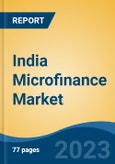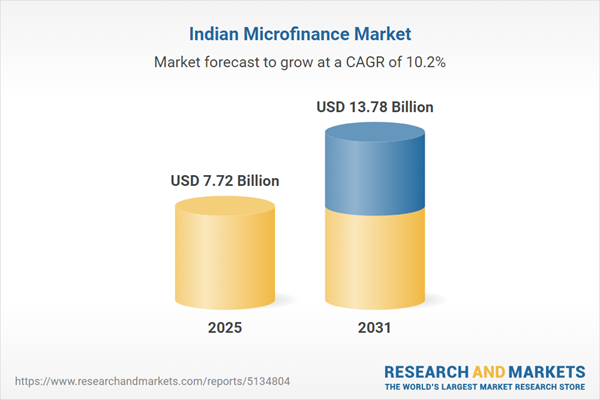Speak directly to the analyst to clarify any post sales queries you may have.
10% Free customizationThis report comes with 10% free customization, enabling you to add data that meets your specific business needs.
Since the Reserve Bank of India (RBI) initiated regulatory oversight in 2011, the sector has grown substantially, with the gross loan portfolio increasing from ₹17,000 crore in 2012 to over ₹3.93 lakh crore in 2024. Microfinance institutions (MFIs) now serve approximately 8 crore borrowers across 723 districts, including underserved and aspirational regions. The sector contributes around 2.03% to India’s Gross Value Added (GVA) and supports over 1.3 crore jobs. Looking ahead, the future of microfinance in India lies in leveraging digital tools, enhancing credit delivery, and expanding financial services to previously excluded segments through innovative and sustainable models.
Key Market Drivers
Financial Inclusion and Government Initiatives
The growth of the India Microfinance Market is strongly supported by the government’s commitment to financial inclusion. Initiatives like the Pradhan Mantri Jan Dhan Yojana (PMJDY) have played a pivotal role in bringing millions of unbanked citizens into the formal financial system, with over 500 million accounts opened as of 2024. Additionally, the Micro Units Development and Refinance Agency (MUDRA) has significantly boosted access to microcredit for small businesses and entrepreneurs, with cumulative disbursements exceeding INR 25 trillion by March 2024. These policy measures, along with RBI’s priority sector lending mandates, have empowered microfinance institutions to reach remote and low-income populations. Regulatory encouragement and risk-sharing mechanisms have enabled MFIs to extend credit to first-time borrowers, thereby driving sectoral growth and enhancing credit penetration across rural and semi-urban areas.Key Market Challenges
Over-Indebtedness and Credit Risk
A key challenge in the microfinance sector is the issue of borrower over-indebtedness. The accessibility of microloans and limited formal credit assessments have led to multiple borrowings, which increase the risk of default. Many borrowers lack verifiable income records, making it difficult to accurately gauge their repayment capacity. Additionally, informal income sources make them susceptible to economic disruptions, such as health emergencies or crop failures. This raises default rates and undermines the financial sustainability of MFIs. Over-borrowing can also lead to reputational risks and public backlash, as witnessed in prior microfinance crises in certain states. To mitigate these issues, the sector needs more robust credit assessment systems, a unified borrower database, and stronger financial literacy programs to promote responsible borrowing.Key Market Trends
Digital Transformation and Fintech Integration
The microfinance sector in India is undergoing a digital transformation, driven by increased fintech participation and adoption of technology across operations. Traditional manual systems are being replaced by digital platforms that streamline loan disbursement, collections, and borrower onboarding. Mobile wallets, Aadhaar-based authentication, and UPI transactions are improving efficiency and enabling secure, cashless interactions. Fintech partnerships are helping MFIs leverage alternative data - such as mobile usage and payment history - for credit evaluations, expanding credit access for underserved populations. As internet and smartphone penetration grow across Tier II, Tier III, and rural areas, digital microfinance is becoming more scalable and transparent. This technological shift not only reduces costs but also enhances customer experience and credit delivery speed, enabling MFIs to serve a broader client base more effectively.Key Market Players
- Ujjivan Financial Services Limited
- Asmitha Microfin Ltd.
- Utkarsh Small Finance Bank Limited
- CreditAccess Grameen Limited
- Share Microfin Limited
- Spandana Sphoorty Financial Ltd.
- Bhartiya Samruddhi Finance Limited (BSFL)
- Bharat Financial Inclusion Limited
- BSS Microfinance Limited
- Muthoot Microfin Limited
Report Scope:
In this report, the India Microfinance Market has been segmented into the following categories, in addition to the industry trends which have also been detailed below:India Microfinance Market, By Provider Type:
- Banks
- NBFCs
- Fintech
India Microfinance Market, By Purpose:
- Agriculture
- Household
- Manufacturing/Production
- Trade & Services
- Others
India Microfinance Market, By Tenure:
- Less than 1 Year
- 1-2 Years
- More than 2 Years
India Microfinance Market, By Region:
- North
- South
- East
- West
Competitive Landscape
Company Profiles: Detailed analysis of the major companies present in the India Microfinance Market.Available Customizations:
With the given market data, the publisher offers customizations according to a company's specific needs. The following customization options are available for the report.Company Information
- Detailed analysis and profiling of additional market players (up to five).
This product will be delivered within 1-3 business days.
Table of Contents
Companies Mentioned
- Ujjivan Financial Services Limited
- Asmitha Microfin Ltd.
- Utkarsh Small Finance Bank Limited]
- CreditAccess Grameen Limited
- Share Microfin Limited
- Spandana Sphoorty Financial Ltd.
- Bhartiya Samruddhi Finance Limited (BSFL)
- Bharat Financial Inclusion Limited
- BSS Microfinance Limited
- Muthoot Microfin Limited
Table Information
| Report Attribute | Details |
|---|---|
| No. of Pages | 70 |
| Published | July 2025 |
| Forecast Period | 2025 - 2031 |
| Estimated Market Value ( USD | $ 7.72 Billion |
| Forecasted Market Value ( USD | $ 13.78 Billion |
| Compound Annual Growth Rate | 10.2% |
| Regions Covered | India |
| No. of Companies Mentioned | 10 |









